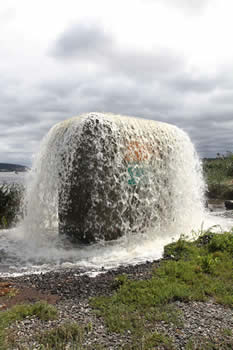Blowout of the sewage discharge system Piermont pier, Sept. 28 2011 Photo by the Author
Dephragging the Marsh: Why is Phragmites invading the Sparkill Creek watershed and the Piermont marsh?
The author's observations on local watershed conditions, based on living next to the Sparkill creek and Piermont marsh for 12 years.
According to reports and historical data, some 20 or more years ago the Piermont Marsh carried a healthy mix of native species, which has been replaced by a large (almost, but not quite) monoculture of an invasive species, Phragmites.
The reasons for this may seem excessively complex, but most of it probably boils down to a simple set of issues. Almost all of them are not reversible on any short or medium term basis, because the essential cause is the increase in population and real estate development in the Sparkill Creek watershed over the last 20 to 30 years.
Population The human population in this part of Rockland County has undergone significant increases during that period. This has led to the widespread building of new and additional houses, clearing of forests, and a significant increase in the number of spaces which afford less water absorption in an area where the bedrock is already near the surface and the water table tends to saturate easily. What it means is that there is a lot more runoff into the creek in the watershed area than there used to be.
Development Secondly, real estate development has resulted in the addition of many lawns, large flat areas that, in addition to increasing runoff, invite the widespread application of fertilizers and pesticides. This has been compounded by the arrival of major chains such as Home Depot and Lowes into the area, who aggressively market large quantities (tens of thousands of pounds) of nitrogen fertilizers, herbicides, and pesticides to the customer base. These products were not as readily available in the county in earlier decades, and it seems reasonably certain that the increased availability, strictly a function of the marketing of the products, has led to vastly increased use, and a dramatic increase in the amount of fertilizer runoff through the Creek into the marsh, which lies directly south of the mouth. All—100%— of this product has nowhere else to go; if 100,000 pounds of fertilizer are applied in the Sparkill Creek watershed, all of the runoff goes down through the creek into the marsh.
The critical point to remember here is that native salt marsh species such as spartina thrive in marginal environments where salt levels are higher and such nutrients are generally less available. They're not adapted for environments with richer, more fertile soils, and can't compete as effectively in them. The reason they succeed where they do is simply because of their ability to tolerate conditions which other species can't.
Added nitrogen and phosphorus favor more aggressive species such as phragmites, which grow much better under such conditions.
Affluence A third factor to consider is the increasing affluence of the households in the Sparkill Creek watershed. People with more money tend to be interested in showing it off. This means more lawns, larger lawns, and more lawn maintenance, all of which leads to increased application of fertilizer to the acreage draining into the Sparkill Creek. People of lesser financial means do not tend to spend their money on bags of fertilizer to put on their lawn; people with money to do so are far more prone to take such action. And indeed, the local authorities on home and lawn care — which are retail operations such as Home Depot and Lowe's, not geologists, biologists and hydrologists (that is, actual authorities, as opposed to sales organizations)— assure them in their marketing displays that this action is, in fact, necessary and desirable.
The principle is simple: affluence leads to effluence. These are pretty simple facts that anyone can understand without a degree in bio.
Before we go any further, let us take note that this situation will not change, no matter how much wishful thinking is applied to it by conservationists of various stripes. As such, it must be considered permanent, and will affect the Creek no matter what biologists or conservationists do to the marsh.
Invasion I hypothesize that the main reason that the invasive species phragmites has come in and taken over in the last 20 years must be attributed principally to these progressive changes in the environment, since the species has been present in the area for much longer than that, and did not gain a stronger foothold before the 1990s.
As such, we need to look to said changes in the actual physical environment to explain the explosion of the phragmites, and the above cited explosion in fertilizer use and the resultant runoff into the creek has to be one of the major contributing factors, since it is the most obvious one. Occam's razor suggests one need look no further; yet there is a second major contributor to this runoff.
That second factor is sewage discharged both accidentally and deliberately by the Orangetown sewage works. Not only does the county allow the intentional discharge of this runoff into the river; repeated catastrophic blowouts of the sewage system lines on Ferdon Ave. (which I live on and have personally witnessed, reported, and documented with photographs on multiple occasions) has caused enormous surges of sewage to run into the creek and, of course, the Hudson River. The nutrients from these surges end up in the marsh before they continue downstream. The roots of the phragmites slow water flow down, causing the particulate sewage effluvients (that is, poop) to drop out of the water column.
The street in front of my house has been afloat in wads of toilet paper during these blowout episodes, which are spectacular and involve water gushing from manhole covers for hours, and even days, on end. And E. Coli is present in Sparkill Creek sediments as a result.
In the first case, it's quite clear that consumer choice and an inevitable increase in population and affluence over time has contributed to (if not caused!) the problem with the invasive species.
In the second case, the town has clearly mismanaged its responsibilities and is using the river as a waste disposal area. The marsh has directly suffered from this, and if anyone ought to be held financially responsible for the cleanup, it is not the taxpayer, but the utility and the county officials who have allowed it to operate in this manner. Unfortunately, the DEC plan does not contain funds to prosecute lawsuits against these operations, but perhaps that should be considered.
Action The overarching question to ask is whether there is any point to attempting to restore the marsh, given that the two main conditions causing excess fertilizer runoff (which, of course, is accompanied by a large amount of undesirable pesticide runoff applied by well meaning, but biologically uninformed, watershed residents) cannot actually be stopped. At best, the sewage treatment plant and the method in which it operates might be corrected — and this would by far be the most obvious way to improve conditions in the watershed. Nonetheless, given the way that the fertilizer market operates, and the heedless manner in which consumers apply artificial fertilizers to their gardens and lawns, any plan to restore the marsh will probably need to be a plan that is perpetual, since the conditions feeding the invasive species will not go away. There is no practical way to filter the runoff from Sparkill Creek; and if conditions of excess nitrogen don't go away, the task of keeping the marsh in a condition other than the one it is currently in will become a Sisyphean one indeed.
Circumstances The situation is analogous to the fertilizer runoff from the Mississippi River, albeit on a much smaller scale. It's well known to biologists that the most serious and devastating pollution in the Gulf of Mexico is this fertilizer runoff, which has resulted in a massive dead zone that dwarfs and eclipses any damage that the BP oil spill did; yet instead of going after the agricultural businesses in the Midwest who are wreaking havoc with their fertilizer applications, the country has decided to sue BP, with great fanfare, even though it is our corn farmers who are killing the Gulf. This is another case where expediency trumps both common sense and the facts — which is exactly what is happening in the DEC plan to restore the marsh. The factors creating the invasion of phragmites are almost certainly far too complex to actually correct; as such, the ecosystem, which is simply undergoing a natural succession based on suitable species and actual physical conditions, cannot be managed except as a landscaping project at taxpayer expense. If the marsh and the surrounding area are allowed to continue to evolve at the rate and given the conditions that are provided, no great harm will be done. If we interfere with the destruction of the current conditions at what is objectively great expense, by killing off the phragmites, it is the equivalent of putting a Band-Aid on cancer. It has no actual effect whatsoever on the root causes of the problem, which will continue to favor the regrowth of phragmites.
Summary I believe that this information is already well known to biologists, and should be self-evident to anyone with common sense who looks at the situation from a macroscopic point of view. This raises the question of why plans to spray herbicide in the marsh were ever forwarded in the first place, and why officials are not more aggressively looking at the proper management of the watershed area of the Sparkill Creek, which is where the problems originate. Cleaning this Creek and its waters up by progressive legislation to control the use of pesticides, herbicides, fertilizers, and the discharge of sewage has to take priority over any meddling with the plant life in the marsh, since the undesirable plant life in the marsh is there because of these problems.
The lesson to be learned is that we, the local residents, are ultimately responsible for the conditions around us. Better education of the public, intelligent application of restraints on poor watershed practice, and other measures are needed.
Spraying poisonous herbicides on marsh grass addresses none of this, and is in fact a distraction from the real problems. |
The Hudson River Diaries: Photo essays by the author on the marsh and its surrounding environs |
| My letter to the DEC on spraying in Piermont Marsh |
| Glyphosates and You: Why herbicides with this chemical must not be used. |
| Why gut bacteria are important to you, and why you ought to care a lot. |
| My exchange with the Audubon Society |
| Links on why chemical pollution of waterways is a major issue |
|
|
|
Nefersweetie an incidental web space created and supervised by Lee van Laer |

